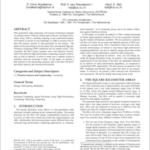An international group of scientists led by the University of Cambridge has finished designing the ‘brain’ of the Square Kilometre Array (SKA), the world’s largest radio telescope. When complete, the SKA will enable astronomers to monitor the sky in unprecedented detail and survey the entire sky much faster than any system currently in existence. “We estimate SDP’s total compute power to be around 250 PFlops – that’s 25% faster than IBM’s Summit, the current fastest supercomputer in the world.”
Square Kilometer Array in HPC
Next generation radio telescopes will require tremendous amounts of compute power. With the current state of the art, the Square Kilometer Array (SKA), currently entering its pre-construction phase, will require in excess of one ExaFlop/s in order to process and reduce the massive amount of data generated by the sensors. The nature of the processing involved means that conventional high performance computing (HPC) platforms are not ideally suited. Con- sequently, the Square Kilometer Array project requires active and intensive involvement from both the high performance computing research community, as well as industry, in order to make sure a suitable system is available when the telescope is built. In this paper, we present a first analysis of the processing required, and a tool that will facilitate future analysis and external involvement.





